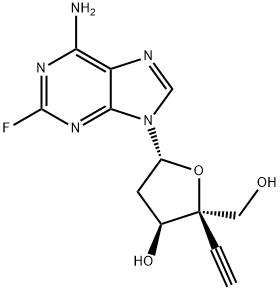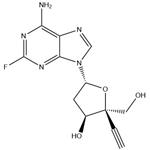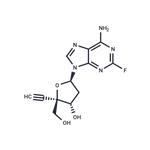Description
Islatravir belongs to a group of HIV drugs called nucleoside reverse transcriptase translocation inhibitors (NRTTIs). NRTTIs use several different methods to block an HIV enzyme called reverse transcriptase. By blocking reverse transcriptase, NRTTIs prevent HIV from multiplying and can reduce the amount of HIV in the body. This compound may be effective against certain HIV strains that are resistant to other HIV drugs.
Uses
MK-?8591 is a carbocyclic nucleoside reverse transcriptase translocation inhibitor and is used as an antiviral with potential use towards the treatment of HIV.
Uses
4'-ethynyl-2-fluoro-2'-deoxyadenosine (Islatravir) is a heterocyclic organic compound and can be used as pharmaceutical intermediates.
Mechanism of action
Islatravir belongs to a group of HIV drugs called nucleoside reverse transcriptase translocation inhibitors (NRTTIs). NRTTIs use several different methods to block an HIV enzyme called reverse transcriptase. By blocking reverse transcriptase, NRTTIs prevent HIV from multiplying and can reduce the amount of HIV in the body. This compound may be effective against certain HIV strains that are resistant to other HIV drugs[1].
Pharmacokinetics
Islatravir is converted intracellularly by endogenous kinases to its active triphosphate (TP) form, islatravir-TP, which has a long intracellular half-life, allowing the potential for various dosing options and regimens. In participants without HIV, single oral doses of islatravir were rapidly absorbed, with peak plasma concentrations attained at ~ 0.5 h, with islatravir demonstrating a half-life of ~ 49–61 h. Peak intracellular islatravir-TP concentrations were attained 6–24 h after islatravir administration, with a half-life of 118–171 h; similar pharmacokinetics have been observed in people living with HIV-1. When administered once daily (QD), oral doses of islatravir resulted in steady-state plasma concentrations at approximately Day 14. At the same time, intracellular islatravir-TP reached a steady state by Day 28 and remained above the concentration threshold associated with antiviral efficacy (0.05 pmol/106 cells) for ~ 30 days following cessation of dosing. In addition, doses as low as 0.25 mg QD produced intracellular islatravir-TP concentrations exceeding the therapeutic concentration threshold on Day 1[1].
References
[1] Randolph P Matthews. “A Phase 1 Study to Evaluate the Drug Interaction Between Islatravir (MK-8591) and Doravirine in Adults Without HIV.” Clinical Drug Investigation (2021): 629–638.




